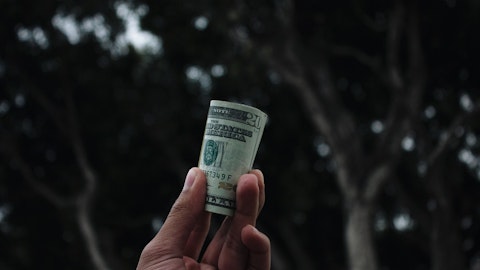David Bishop: Got it and one final question. You noted the uptick in SBSL charge-offs. Just curious on a dollar basis or what percent of the current quarter and last quarter were related to the — that segment? Thanks.
Heath Fountain: So last quarter, a majority of those net charge-offs were related to SBSL, but that was a smaller portion this quarter. So it was — I would say probably about 60% to 70% this quarter related to SBSL. So there were some — that was one of the leading impacts really on our net charge-offs for both quarters.
David Bishop: Great. Thank you. I’ll hop back into the queue
Operator: [Operator Instructions] Your next question comes from Chris Marinac from Janney Montgomery Scott. Please go ahead.
Christopher Marinac: Hey, thanks. Good morning. Thanks for hosting us this morning. I wanted to ask a little bit about the AOCI improvement. The information that you gave us in the slide deck about the various buckets, is — those are pretax. So I’m just trying to compare the total change in the AOCI with those three buckets because it looks like there was some offset beyond taxes. And I just want to understand that better. Is there more AOCI recovery that can happen in the future?
Heath Fountain: Yes, Chris. So in addition to our investments, we do have a small amount of interest rate swaps that would offset that. I think it was just a few hundred thousand dollars during the quarter. I guess, quarter-over-quarter, that move was about a million because we had a gain in those swaps of about 700 last quarter and then a loss this quarter of 300, so you have about a million move there. But that’s obviously a fraction of the improvement we saw on the security side. So we continue to the terms on these securities are coming in. We try to — they’re rolling down the curve. But obviously, the biggest move to that would be if we continue to see rates come down.
Christopher Marinac: Got it. That makes sense. Thank you for that. I appreciate that. And then when we look at the loan yield that you have seen increased loan yields over many quarters, is there additional loan yield bumps that can happen even as the portfolio turns or just sort of a natural rate increases go through? I’m just kind of curious if there’s more loan yield that’s available in this next 12, 18 months?
Heath Fountain: Yes. I think there is, and that’s kind of what we’re forecasting in our budget for the year. I don’t — we do have loans that will be repricing. We’ll have new loans coming on at higher rates. And so we’ll see the pickup across the next year, but I think it will be similar to what we’ve seen over the past couple of quarters.
Derek Shelnutt: Yes. And I’ll just add, Chris. I mean, our total loan yield, I think, is 565 for the quarter. We’re putting loans on in the 8s or in some cases in the high 7s. Our total duration of our loan portfolio is just over 2.5 years. And so we have several hundred million dollars of loans repricing each year. So obviously, we’re working hard to push the yields up on these renewals. And so it not having net growth will limit some of that, but there’s still a significant opportunity to move our loan yields up. And I think in the last few quarters, it slowed down some of that yield increase because we’ve been coming off of such a low base, but there’s still an opportunity each quarter to get some nice increases on our loan portfolio.
Christopher Marinac: And Heath, the mix between fixed and variable, do you see that kind of still being relatively the same in the next year or so?
Heath Fountain: Well, actually, so from a production standpoint, we are seeing continued more production on the variable side the last couple of quarters. But from an overall standpoint, we’re still at a high percentage, still a higher percentage on the fixed side, but we are chipping away at that.
Christopher Marinac: Great. That’s helpful. And then last question for me is, there’s a slide, I think it’s number 12 about the sort of data and analytics that you’re now harvesting. I’m sure it’s still early for what you want to do with that. But what do you envision that data does for you this next year or two? I mean do you kind of cross-sell the same customer just more business at a better profit margin? Do you see that data kind of helping you get net new customers? I’m just sort of curious how you think through kind of where that’s going to take you.
Heath Fountain: Yes. That’s a great question. And we are a little early on. We’ve really been building the data infrastructure for the last year, 1.5 years, and we have that infrastructure in place at this point. Now it’s about utilization of the data and really trying to allocate that to the highest priority of where it can drive the biggest increase in revenue. So we have nearly 100,000 customers. And what we’re trying to do is take that data and utilize that to present marketing opportunities to put in front of our bankers to make sure that we know where our — both on the deposit side, where our customers’ other business is, where we can drive customers to wealth, insurance, merchant services. So really, the bulk of what’s been driving our increased revenue in our business lines, and what’s been driving our business development as a company has been just sheer calling effort.
And what we hope to do is by utilizing that data, it’s going to give us marketing to present that information both to put it in front of the customer, but also to our bankers to be able to direct that marketing or that calling effort. And so that’s a big focus of ours this year and next year. And we think that’s kind of the future. That’s why it’s important for us to have multiple lines of business to be able to drive more revenue per customer, and help to optimize that customer base that we have and out in a relatively small average-sized branch. So if we can get that revenue up from other services, it really makes that low-cost deposit network is great, but there are higher expenses. So that helps offset to increase this revenue. And I think we should see continued improvement on the noninterest income side from that for a long time.
We’re just scratching the surface of that.
Christopher Marinac: Great. That’s really good color. Thank you both for the time and background this morning.
Heath Fountain: Thank you, Chris.
Operator: Your next question comes from David Bishop from Hovde. Please go ahead.




